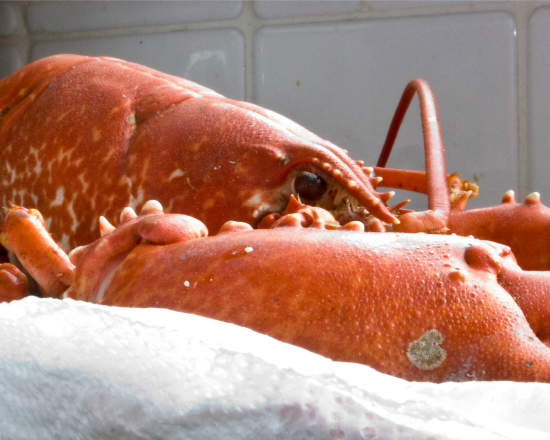Holed up post-blizzard, our editors consider lobsters with David Foster Wallace, imagine how dietary restrictions would fly in Middle Earth and share Long Island–inspired seafood cookbooks. Dig in.
Betsy Davidson: Long Island Seafood Cookbook — J.George Frederick
First published in 1939, this no-frills cookbook is my go-to source when presented with a bag of bivalves by a hungry clammer husband. With a chapter devoted entirely to clams (52 recipes), my basic white clam sauce will soon become obsolete.
Eileen M. Duffy: The World Atlas of Wine — Hugh Johnson & Jancis Robinson
This book is indispensable for any wine student. I used it daily when studying for my diploma in wine and spirits. I also use it for geography, as it seems to be the only atlas in the house. This new update is better than ever with the inclusion of even more wine regions and more detailed maps. But the biggest news is that it’s now available as an iBook; you can zoom in on maps and of course it’s searchable.
Gabrielle Langholtz: The Need for Speed — Medium
My favorite reads are invariably about feasting on the fruits of good farms, and the process behind growing and cooking them. But one of the best things I’ve read in a while is about ingesting something quite different: speed. Author Josh Ozersky is one of the best food writers out there, and in this piece he turns the lens away from the stove or plate and onto his own keyboard. It is a story about taking uppers, but moreover, it is an honest story about the agony and ecstasy of writing.
Brian Halweil: The Top Food and Agriculture Stories of 2013 in 10 Maps — Modern Farmer
This map-based, year-end listicle conveys a ton of information since food is so much about how we touch the landscape. The global aquaculture map is the best representation I’ve seen of Asia’s dominance in fish farming. (A map of where farmed fish are eaten would be nearly the opposite, with anemic North America and Europe swelling considerably.) The drone-generated farm map from Malaysia, on the other hand, has implications too big for the overly optimistic summary: “Drone technology has huge promise for farmers.”
Carrington Morris: Forget Organic: This Farmer Has 100 Types Of Fruit Trees In His Permaculture Orchard — Fast Company
What he initially envisioned as an organic apple orchard, biologist and educator Stefan Sobkowiak has transformed over the past 20 years into an ecosystem teeming with life. “I haven’t fertilized since 2007,” he enthuses on the Kickstarter campaign clip for the upcoming documentary on Miracle Farms. Instead he plants using permaculture techniques where the biodiversity itself supplies the life-generating pulse. The thriving orchard boasts a hundred cultivars of apples, plus pears, plums, peaches, grapes, berries, cucumbers, beans and more, and hosts wildlife from birds and bees to “we’ve never seen so many snakes” and “all kinds of frogs.” He wants the world to know this type of cultivation is possible, viable and makes sense on a commercial scale.
Amy Zavatto: Consider the Lobster — Gourmet
From my former days as a book editor, I still subscribe to the Publishers Weekly e-blast to see what’s going on in the behind-the-scenes world of the printed word, be it on a page or a screen. Today’s perfunctory end-of-the-year wrap-up theme included a provocative heading: “The Top 10 Essays Since 1950” compiled by Robert Atwan, founder of The Best American Essays series. Among the pieces by Susan Sontag, Joan Didion and James Baldwin was one that surprised me — Consider the Lobster, an essay about, for lack of a better way to put it, how a lobster feels when we kill it by David Foster Wallace. The interesting thing about it, aside from the well-researched and, often, very funny writing, was as he built his looking-at-it-from-both-sides case the inevitable conclusion kind of made him stop the whole damn thing rather abruptly at the end of this 8-page piece, plus footnotes (20 in total, and all worth reading, if not thoroughly necessary, as they are more asides and tangents rather than attributions). The conclusion, of course, being — yes, a lobster experiences something not so nice when we kill it. And thus making the conversation really more about — for those of us who consume living creatures, what do you experience? How do you experience it? Do you divorce yourself from it entirely (“La, la, la, I’m not really killing you because you’re not as smart as me!” or “La, la, la, even though you’re struggling while I kill you it’s okay because you’re just food!” or “La, la, la, this is really freaking me out and I’m going to throw you in a pot and run like hell into another room so I don’t have to listen to your last moments of struggle!”)? Find ways to acknowledge your role in a live kill (e.g., stabbing it through the head)? Or avoid cooking it at home at all and thoroughly displace these thoughts by ordering it off a menu? It’s a good read and, though written nearly 10 years ago, as relevant and apt to bring about what can only be called Lively Debate as if it were just fresh off the keyboard. If any of you do take the time for this one, I’d love to hear what you think.
Lauren Wilson: Dietary-Restricted Middle Earth — McSweeney’s
Truth be told, I’m a bit of a LOTR obsessive. Many (including NPR) have pointed out Tolkien’s fondness of good food and drink, which (if you’re familiar with the stories) is most obviously illustrated by the lifestyles of the hobbits who graze on bacon, “taters” and mulled cider. You may need some background knowledge to appreciate this piece, which jests about modern diets and Middle Earth stereotypes. However, you don’t need any knowledge of the trilogy to recognize the appeal of this Shire-inspired recipe for lavender and lemon muffins.
Featured photo credit: Flickr/davehoban147



